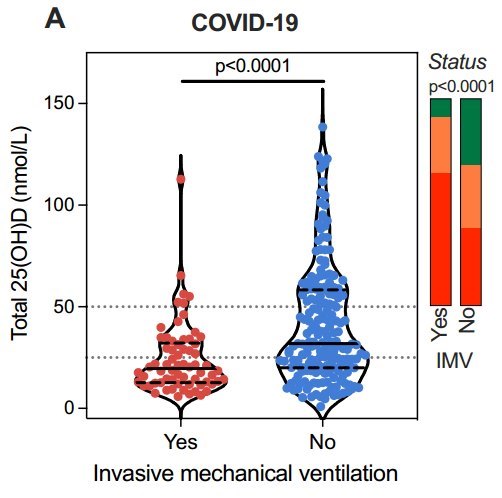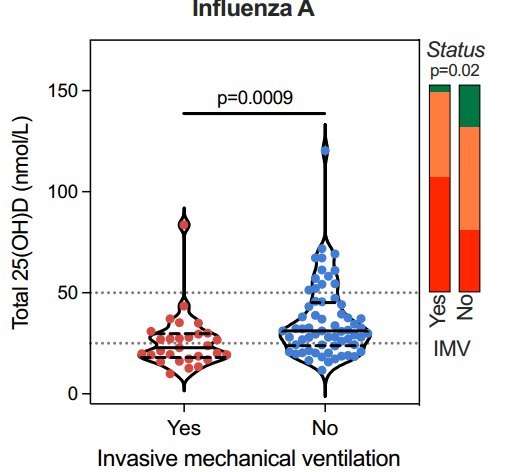COVID-19 and Influenza patients needing ventilation had low Vitamin D
Vitamin D insufficiency in COVID-19 and influenza A, and critical illness survivors: a cross-sectional study
BMJ Open 2021;11:e055435. doi:10.1136/bmjopen-2021-055435
Hurst EA, et al, Correspondence to Dr Clark D Russell; clark.russell@ed.ac.uk
COVID-19 patients needing Invasive Mechanical Ventilation had lower Vitamin D

Influenza patients needing Invasive Mechanical Ventilation had lower Vitamin D

Objectives The steroid hormone vitamin D has roles in immunomodulation and bone health. Insufficiency is associated with susceptibility to respiratory infections. We report 25-hydroxy vitamin D (25(OH)D) measurements in hospitalised people with COVID-19 and influenza A and in survivors of critical illness to test the hypotheses that vitamin D insufficiency scales with illness severity and persists in survivors.
Design Cross-sectional study.
Setting and participants Plasma was obtained from 295 hospitalised people with COVID-19 (International Severe Acute Respiratory and emerging Infections Consortium (ISARIC)/WHO Clinical Characterization Protocol for Severe Emerging Infections UK study), 93 with influenza A (Mechanisms of Severe Acute Influenza Consortium (MOSAIC) study, during the 2009–2010 H1N1 pandemic) and 139 survivors of non-selected critical illness (prior to the COVID-19 pandemic). Total 25(OH)D was measured by liquid chromatography-tandem mass spectrometry. Free 25(OH)D was measured by ELISA in COVID-19 samples.
Outcome measures Receipt of invasive mechanical ventilation (IMV) and in-hospital mortality.
Results Vitamin D insufficiency (total 25(OH)D 25–50 nmol/L) and deficiency (<25 nmol/L) were prevalent in COVID-19 (29.3% and 44.4%, respectively), influenza A (47.3% and 37.6%) and critical illness survivors (30.2% and 56.8%). In COVID-19 and influenza A, total 25(OH)D measured early in illness was lower in patients who received IMV (19.6 vs 31.9 nmol/L (p<0.0001) and 22.9 vs 31.1 nmol/L (p=0.0009), respectively). In COVID-19, biologically active free 25(OH)D correlated with total 25(OH)D and was lower in patients who received IMV, but was not associated with selected circulating inflammatory mediators.
Conclusions Vitamin D deficiency/insufficiency was present in majority of hospitalised patients with COVID-19 or influenza A and correlated with severity and persisted in critical illness survivors at concentrations expected to disrupt bone metabolism. These findings support early supplementation trials to determine if insufficiency is causal in progression to severe disease, and investigation of longer-term bone health outcomes
📄 Download the PDF from VitaminDWiki
VitaminDWiki
COVID-19 treated by Vitamin D - studies, reports, videos
- {include}
Overview Influenza and vitamin D
See also Flu update 2018 which has the following
{include}
VitaminDWiki pages with INFLUENZA of FLU in title
This list is automatcially updated
{LIST()}
